Rigid-frame fabric buildings are designed to last against environmental challenges.
By Matt VanScoyoci
The waste industry has a broad array of building needs. Wastewater treatment plants, compost covers, and material recovery facilities—to name a few—all represent very different challenges when engineering a proper facility. However, there is an obvious common bond among all waste industry buildings: All need to be protected against corrosive elements.
Tension fabric structures have been a popular choice for waste-related applications for decades for this very reason. The fabric membrane cladding that comprises a building’s roof and sidewalls is naturally corrosion-resistant, leaving only the structural frame and components as potentially vulnerable. However, even those concerns have been alleviated by recent advancements in the design and manufacturing of fabric buildings.
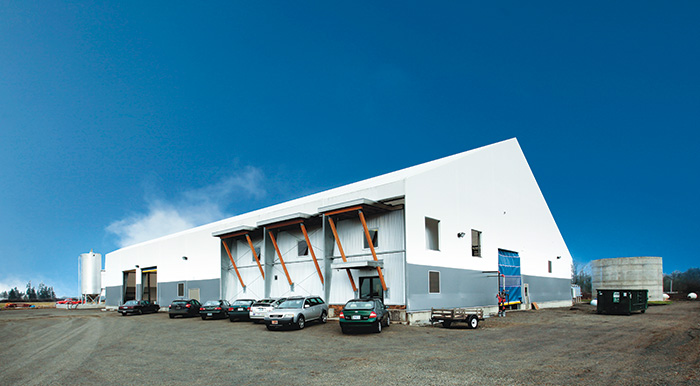
Photos courtesy of Legacy Building Solutions.
Fabric Cladding
When one thinks about the caustic materials making their way in and out of various waste facilities, it is clear to see why most prefer the inherent corrosion resistance of polyvinyl chloride (PVC) or polyethylene (PE) fabric to sheet metal as a cladding choice for a building.
For many years, PE fabrics were the most affordable and most common roofing option. That has changed, thanks to the introduction of a new PVC fabric. The unique composition of this PVC provides twice the tensile strength of a standard PE fabric, and yet it is available at a comparable price point. In effect, users can extend the roof’s life expectancy without any additional project investment.
Fabric’s thermal emittance and solar reflectance properties also commonly help keep building interiors warmer in the winter and cooler in the summer months. The white PVC fabric provides 12 percent translucency, offering the added advantage of natural light, which can often help cut down on artificial lighting requirements and costs.
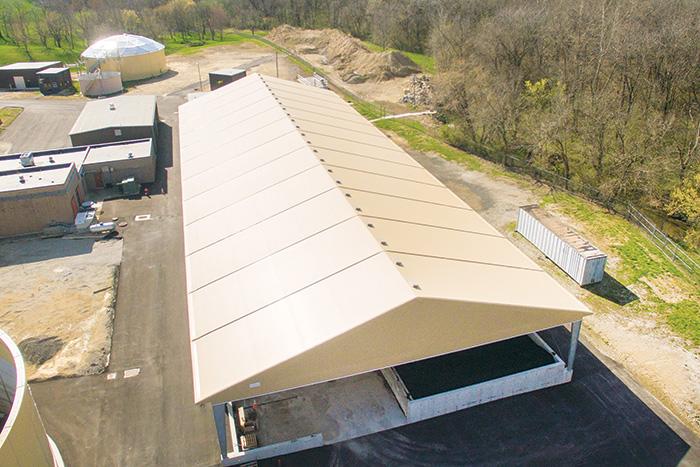
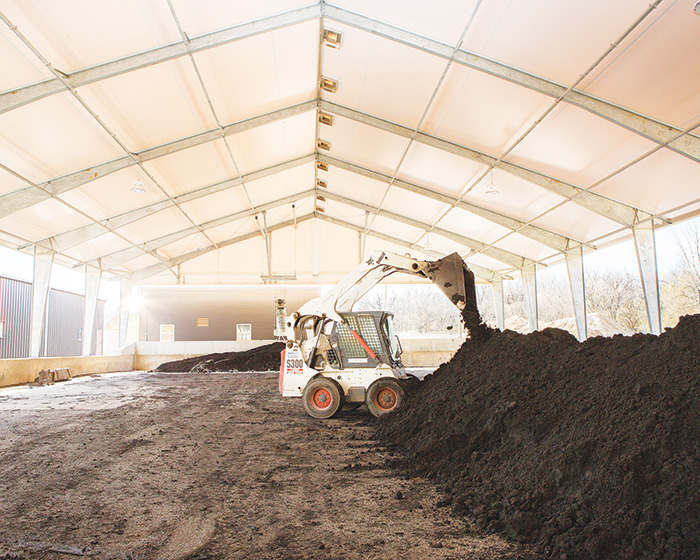
Improving the Structure
Despite having a superior cladding for corrosion protection, fabric buildings historically have not been without their flaws. Open web truss designs, sometimes referred to as a “hoop structures”, used hollow-tube steel frames that were vulnerable to rust attacking from the inside the tube. The overall engineering of these structures was also considered to be subjective.
Both issues were addressed when we introduced rigid-frame engineering to tension fabric buildings. The use of structural steel I-beams is proven and universal, bringing an objective level of engineering integrity to the market. The fact that I-beams are solid steel also removed any of the doubt associated with hollow tubes and their tendency to corrode from the inside out.
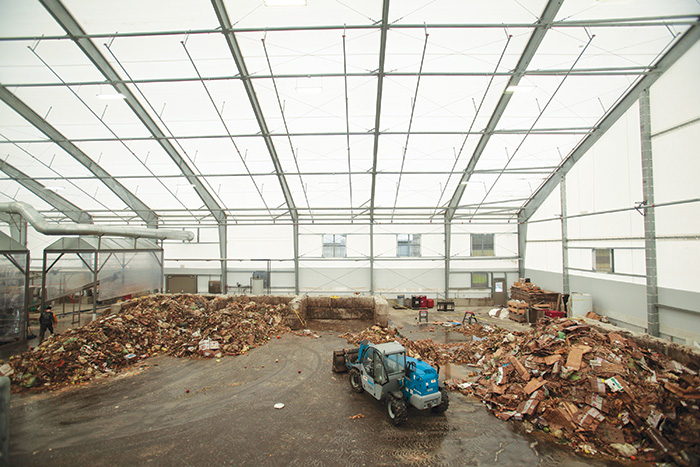
Protecting the Structure
I-beams are solid steel, but they still need external protection from prolonged exposure to the caustic environments they are subjected to in the waste industry. Hot-dip galvanizing has been a popular and effective long-term treatment option for steel beams and other framing components in many applications.
In many instances, particularly in harsh environments, users should consider an epoxy paint coating for the I-beams. Epoxy creates a physical barrier that prevents corrosive elements from ever making contact with the steel, adding years of longevity to a building’s lifespan. Another maintenance advantage with epoxy is that if a coated steel I-beam were ever scratched by equipment or vehicles, that beam can be blasted and re-coated with epoxy to re-seal the barrier.
Customizing the Structure
Experienced waste industry professionals who were involved in acquiring a tension fabric structure of the past may have stories about having to settle for a predetermined size offering from a building manufacturer. For modern buildings with an I-beam frame, there is no such thing as a standard size; every structure is customized with a clean sheet design to meet the exact requirements of the building user.
The shift to rigid-frame engineering effectively made fabric buildings very similar to conventional construction, where projects begin by assessing the user’s needs so that an optimal solution can be created. For example, if trucks, trailers, and other equipment will be tipping and dumping loads inside, a waste facility can be designed from the beginning to provide ample ceiling clearances in an unloading area, without necessarily having to build to the same height across the entire structure.
The stronger structural frame offers the ability to provide any desired layout. For users needing an open floor plan, the building can be engineered with long, clear spans with zero support beams or other features presenting unnecessary obstacles for workers and vehicles on the ground. Buildings can include lean-tos or offset peaks. Users can even choose to have only a portion of the facility be climate-controlled, such as an office buildout, without wasting money on insulating the full structure.
Another benefit of using solid steel beams is that the building will have straight sidewalls, just like any conventional structure. Older-style hoop buildings have curved or rounded frames that do not allow for operational activity near the sidewalls. With straight sidewalls, the available square footage of the building footprint is maximized. Additionally, it is far more practical to add doorways on a straight sidewall than a rounded wall.
The rigid-frame concept also allows engineers to apply hanging loads onto the building frame. Mezzanines or catwalks can be included to oversee operations taking place. Conveyors, cranes, and fire suppression systems can be suspended from the ceiling. To account for any of these desired loads and stresses, each individual I-beam is designed to put more strength exactly where needed, rather than having to over-engineer the structure and add unnecessary material costs.
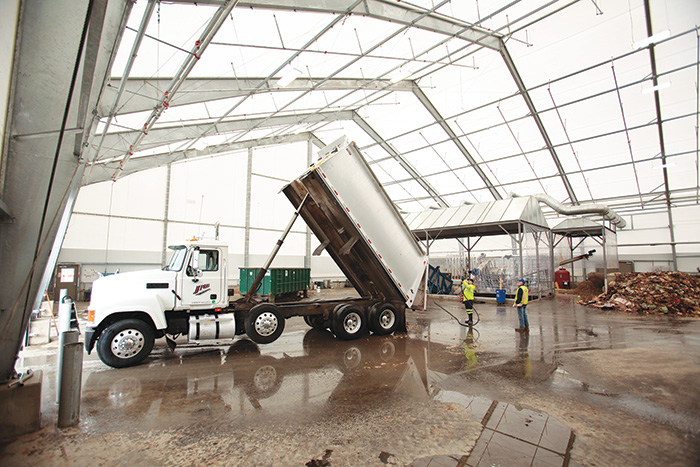
Ventilating the Structure
Another possible hanging load to account for on the structural frame is a mechanical ventilation system, which might be necessary to help move air in certain cases where an airtight building envelope is required. One way or another—depending on building design and application—users will have to alleviate gas emissions, filter out corrosive elements, or simply reduce the persistence of foul odors inside.
Mechanical venting is not needed in every situation. Passive ventilation systems, which rely on the simple movement of warm air, typically come standard on rigid frame building designs. Ridge and soffit vents draw air into the structure and circulate the air out. This passive process is sufficient to handle the humidity and moisture concerns of most facilities.
Composting and sludge storage buildings are yet another circumstance, one in which the structure is built to function mostly as a cover for weather protection. This style of structure allows natural breezes to help clear fumes and promote air movement to accelerate the drying or curing process of the material being covered.
Installing the Structure
There is another reason that tension fabric structures have been chosen for transfer stations, biocycle centers, and numerous other applications—both within the waste market and across other industries. The installation time for a fabric building is often measured in weeks, rather than the months or years you would expect from a metal or brick-and-mortar building option.
Some building manufacturers also employ their own in-house, professional installation crews who are specifically trained to erect fabric structures, rather than outsourcing this work to subcontractors. This helps ensure not only a speedy process, but also proper installation techniques and an optimal final result for any waste industry facility. | WA
Case Study: Covered Sludge Storage in Highland, IL
Keeping things dry is important in a lot of storage situations, and it is especially critical when you are storing biosolid sludge. Bill Zimmer is the plant supervisor for the city of Highland, Illinois, which recently completed an $11.5 million upgrade to its sludge processing operation.
One component of the project was a new tension fabric storage building to keep the biosolids shielded from weather elements. Designed and installed by Legacy Building Solutions, the building features ExxoTec™ industrial PVC fabric for the roof, which is attached to a solid steel I-beam frame. The structure measures 85 by 240 feet, providing ample coverage for the sand beds where the biosolids are dried. The extra 20,400 square feet of capacity gave Highland the ability to handle more materials. “Now we can save anywhere from six months to a year’s worth, depending on how hard we push our digester and our press,” said Zimmer.
With the old building, the city previously had to transfer biosolids to local farmers three of four times per year. However, with most local farmers changing to no-till farming, the frequent biosolids transfers created scheduling problems for Zimmer and his team. The facility’s materials are Class 5 sludge, and regulations required those biosolids to be incorporated into the soil. The trouble was that farmers had shifted to only turning the soil twice a year, in the spring and fall.
With the extra drying capacity, Highland’s operation now better matches the schedules of the farmers. Faster drying also allows Highland to stack the biosolids higher and make better use of space within the building footprint. The extra storage capacity also made the building more cost effective, explained Adrianne Eilers, Project Engineer from Crawford, Murphy & Tilly, who oversaw the city’s upgrade. The project had initially come in over budget during the early bid process, but the final building parameters changed the equation. “Legacy came up with cost savings for us simply by being able to change our occupancy load, allowing us to reduce cost and move the project forward,” said Eilers.
Legacy customizes every building it designs, fabricates and installs. Some designs involve the inclusion of eave extensions for the roof. In Highland’s case, they specified three-foot eave extensions on the open-air building. “When you have rain and melting snow, it doesn’t blow the water into the covered area,” said Zimmer. With Highland’s old building, a traditional structure with steel walls and a tin roof, the roof ended right at the support columns and provided less protection from the weather.
According to Eilers, the longer eaves also helped with the value engineering analysis of the project. Initially they considered having the entire structure enclosed with fabric wall panels to keep materials dry. With the extended eaves, they got the moisture protection they needed while saving money. The open sides of the building encouraged more airflow, further aiding the process of drying the biosolids. The open-air design also helps reduce the caustic factors that can impact the longevity of the structure’s steel frames, which were hot-dip galvanized to aid in corrosion protection. Zimmer is confident that Highland’s building investment will last a long time. Said Zimmer, “This Legacy building has been a very useful upgrade.”
Matt VanScoyoc is a Building and Project Design Consultant for Legacy Building Solutions. He has experience with all aspects of fabric building sales, design-build assistance, and project management. Matt works with end users, contractors, and government entities throughout solicitation, development, review, and submission. He can be reached at [email protected]. For more information, visit www.legacybuildingsolutions.com.
